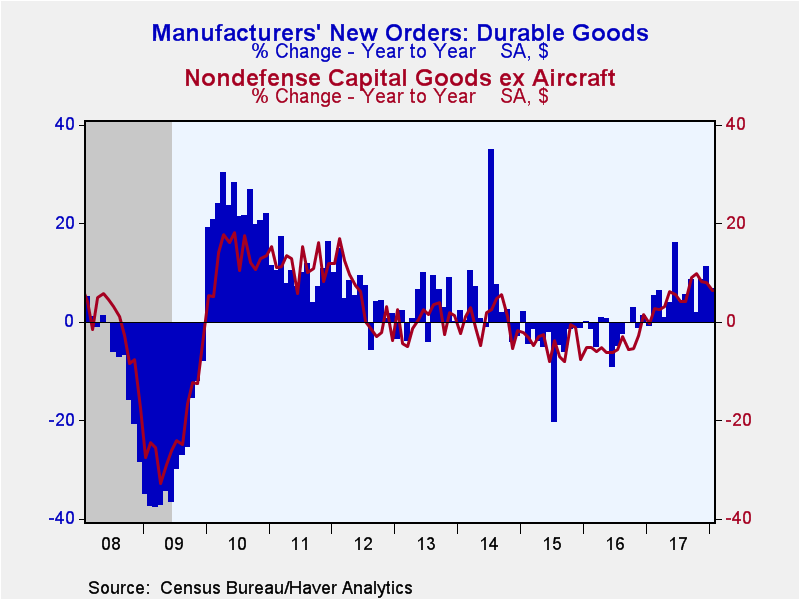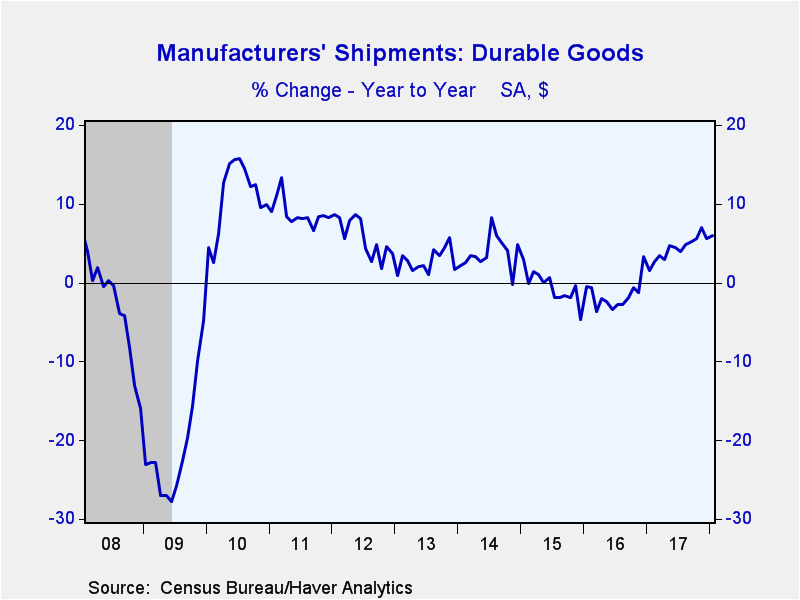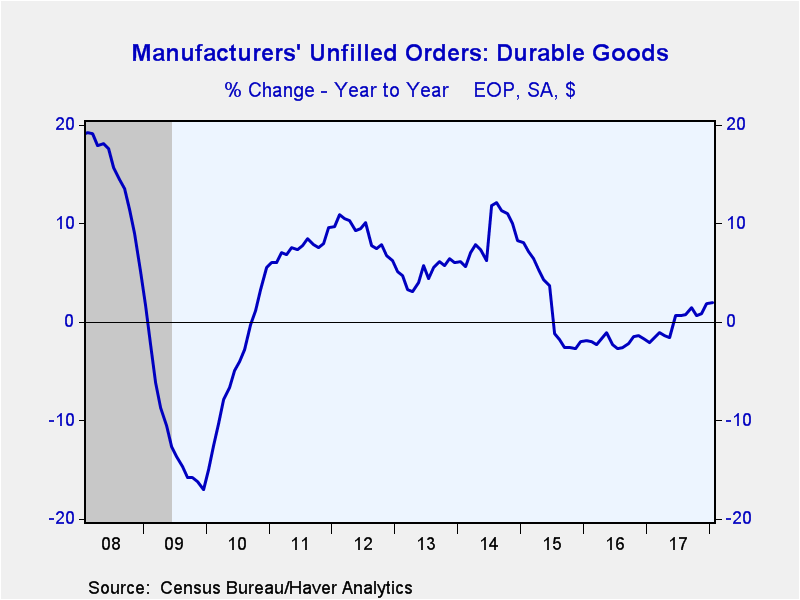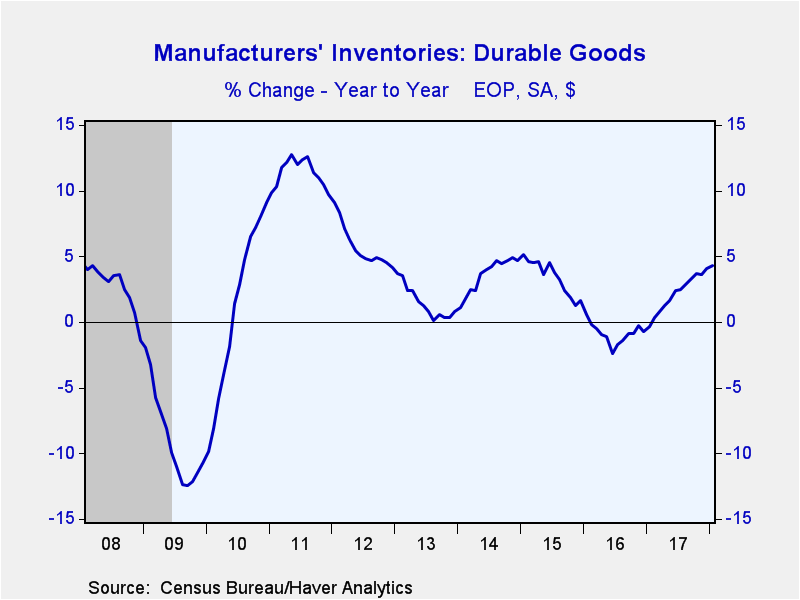 Global| Feb 27 2018
Global| Feb 27 2018U.S. Durable Goods Orders Post Weak Start to Q1
by:Sandy Batten
|in:Economy in Brief
Summary
New orders for durable goods slumped in January, falling a larger-than-expected 3.7% m/m (+8.9% y/y) after having jumped soared 2.6% m/m (revised from a 2.9% m/m gain) in December. The Action Economics Forecast Survey had looked for a [...]
New orders for durable goods slumped in January, falling a larger-than-expected 3.7% m/m (+8.9% y/y) after having jumped soared 2.6% m/m (revised from a 2.9% m/m gain) in December. The Action Economics Forecast Survey had looked for a 2.0% m/m decline in January. The swing from December to January was due mostly to a wild swing in orders for transportation equipment. They fell 10.0% m/m (+8.4% y/y) in January after having risen 6.4% m/m in December and 4.5% m/m in November.
Aircraft orders were again the primary driver of the swing in transportation orders. Total aircraft orders slumped 32.8% m/m in January after gains of 23.0% m/m and 11.6% m/m in December and November respectively. The ups and downs in total aircraft orders were reflected in both defense and nondefense categories. Defense aircraft orders collapsed 45.6% m/m in January, offsetting a 47.8% m/m surge in December. Nondefense aircraft orders tumbled 28.4% m/m in January, offsetting the 16.1% m/m jump December and the 14.1% m/m rise in November.
Excluding transportation orders, new orders in January were still mediocre and slightly weaker than market expectations, falling 0.3% m/m (+9.1% y/y) following a slightly upwardly revised 0.7% m/m gain in December. Of the major categories, primary metals orders fell 0.9% m/m (+13.3% y/y) in January; fabricated metals orders edged up 0.5% m/m (11.7% y/y); machinery orders slipped 0.4% m/m (+9.8% y/y); orders for computers and electronic products rose 0.6% m/m (9.1% y/y); and orders for electrical equipment and appliances declined 0.8% m/m (+0.8% y/y).
Nondefense capital goods orders and shipments excluding aircraft (core orders and shipments) are the variables in this report that are key indicators of business spending on equipment in the national accounts. They both point to a slow start to Q1. Core capital goods orders slid 0.2% m/m (+8.0% y/y) in January, their second consecutive monthly decline, auguring weaker business spending ahead. Core goods shipments (a good real-time indicator of business spending) edged up 0.1% m/m (10.8% y/y) in January but this was after a solid 0.7% m/m rise in December (revised up from 0.4% initially). This points to continued, though more modest, business spending on equipment in Q1.
Shipments of durable goods increased 0.2% m/m (8.2% y/y) in January with small gains reported across most of the major categories. Unfilled durable goods orders fell 0.3% /m (+2.0% y/y) in January, their first monthly decline in the past five months. Inventories of durable goods rose 0.3% m/m (+4.3% y/y) in January on top of a 0.5% m/m increase in December.
The durable goods figures are available in Haver's USECON database. The Action Economics consensus forecast figure is in the AS1REPNA database.
| Durable Goods NAICS Classification | Jan | Dec | Nov | Jan Y/Y | 2017 | 2016 | 2015 |
|---|---|---|---|---|---|---|---|
| New Orders (SA, % chg) | -3.7 | 2.6 | 1.7 | 8.9 | 5.9 | -1.7 | -4.6 |
| Transportation | -10.0 | 6.4 | 4.5 | 8.4 | 4.8 | -3.4 | -6.2 |
| Total Excluding Transportation | -0.3 | 0.7 | 0.4 | 9.1 | 6.5 | -0.7 | -3.6 |
| Nondefense Capital Goods | -1.5 | -0.4 | 2.1 | 12.2 | 7.8 | -7.1 | -11.0 |
| Excluding Aircraft | -0.2 | -0.6 | 0.1 | 8.0 | 5.3 | -4.6 | -4.3 |
| Shipments | 0.2 | 0.5 | 1.3 | 8.2 | 4.3 | -1.6 | -0.6 |
| Unfilled Orders | -0.3 | 0.6 | 0.1 | 2.0 | 1.9 | -1.7 | -2.0 |
| Inventories | 0.3 | 0.5 | 0.3 | 4.3 | 4.1 | -0.7 | 1.6 |
Sandy Batten
AuthorMore in Author Profile »Sandy Batten has more than 30 years of experience analyzing industrial economies and financial markets and a wide range of experience across the financial services sector, government, and academia. Before joining Haver Analytics, Sandy was a Vice President and Senior Economist at Citibank; Senior Credit Market Analyst at CDC Investment Management, Managing Director at Bear Stearns, and Executive Director at JPMorgan. In 2008, Sandy was named the most accurate US forecaster by the National Association for Business Economics. He is a member of the New York Forecasters Club, NABE, and the American Economic Association. Prior to his time in the financial services sector, Sandy was a Research Officer at the Federal Reserve Bank of St. Louis, Senior Staff Economist on the President’s Council of Economic Advisors, Deputy Assistant Secretary for Economic Policy at the US Treasury, and Economist at the International Monetary Fund. Sandy has taught economics at St. Louis University, Denison University, and Muskingun College. He has published numerous peer-reviewed articles in a wide range of academic publications. He has a B.A. in economics from the University of Richmond and a M.A. and Ph.D. in economics from The Ohio State University.










